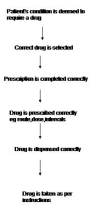The incidence of prescribing errors in an eye hospital
- PMID: 15784154
- PMCID: PMC1079870
- DOI: 10.1186/1471-2415-5-4
The incidence of prescribing errors in an eye hospital
Abstract
Background: Relatively little is known about the incidence of prescribing errors and there has been no work on this in a single specialty ophthalmic hospital. Knowing where and when errors are most likely to occur is generally felt to be the first step in trying to prevent these errors. This study is an attempt in, the setting of an eye hospital, to try to identify and attribute these medication errors.
Methods: The study setting was a single specialty eye hospital geographically separated from the main general hospital. Pharmacists prospectively recorded the number of errors of prescribing during a 4 week period at an eye hospital in UK. The errors were categorised as error of prescription writing or drug error. Potential significance of the errors was not addressed.
Results: Overall 144/1952 (8%) prescription sheets had errors. 7% of the total errors were errors of prescription writing while 1% were drug errors. The majority of errors were made by junior doctors and no drug errors were made by senior doctors. The outpatients department had by far the highest prevalence of errors.
Conclusion: Certain areas within the hospital and certain grades of staff are more prone to drug errors. Further study is required to look at the reasons why this is so and what systems can be put in place to reduce these errors.
Figures
Similar articles
-
Prescribing errors in hospital inpatients: their incidence and clinical significance.Qual Saf Health Care. 2002 Dec;11(4):340-4. doi: 10.1136/qhc.11.4.340. Qual Saf Health Care. 2002. PMID: 12468694 Free PMC article.
-
Prescribing errors in hospital inpatients: a three-centre study of their prevalence, types and causes.Postgrad Med J. 2011 Nov;87(1033):739-45. doi: 10.1136/pgmj.2011.117879. Epub 2011 Jul 14. Postgrad Med J. 2011. PMID: 21757461
-
The incidence and severity of errors in pharmacist-written discharge medication orders.Int J Clin Pharm. 2017 Aug;39(4):722-728. doi: 10.1007/s11096-017-0468-9. Epub 2017 Jun 1. Int J Clin Pharm. 2017. PMID: 28573438 Free PMC article.
-
Outpatient anti-epileptic drug prescribing errors in a Children's Hospital: an audit and literature review.Seizure. 2014 Oct;23(9):786-91. doi: 10.1016/j.seizure.2014.06.010. Epub 2014 Jun 27. Seizure. 2014. PMID: 25023722 Review.
-
[Opportunities for medication errors and pharmacist's interventions in the context of computerized prescription order entry: a review of data published by French hospital pharmacists].Ann Pharm Fr. 2012 Mar;70(2):62-74. doi: 10.1016/j.pharma.2012.02.002. Epub 2012 Mar 20. Ann Pharm Fr. 2012. PMID: 22500957 Review. French.
Cited by
-
Identification of variables influencing pharmaceutical interventions to improve medication review efficiency.Int J Clin Pharm. 2018 Oct;40(5):1175-1179. doi: 10.1007/s11096-018-0668-y. Epub 2018 Jun 2. Int J Clin Pharm. 2018. PMID: 29860706
-
Interns' knowledge of clinical pharmacology and therapeutics after undergraduate and on-going internship training in Nigeria: a pilot study.BMC Med Educ. 2009 Jul 28;9:50. doi: 10.1186/1472-6920-9-50. BMC Med Educ. 2009. PMID: 19638199 Free PMC article.
-
Methods to reduce prescription errors in ophthalmic medication.Saudi J Ophthalmol. 2013 Oct;27(4):267-9. doi: 10.1016/j.sjopt.2013.09.003. Epub 2013 Sep 25. Saudi J Ophthalmol. 2013. PMID: 24371422 Free PMC article.
-
What is the scale of prescribing errors committed by junior doctors? A systematic review.Br J Clin Pharmacol. 2009 Jun;67(6):629-40. doi: 10.1111/j.1365-2125.2008.03330.x. Epub 2008 Oct 23. Br J Clin Pharmacol. 2009. PMID: 19094162 Free PMC article.
-
The impact of preprinted prescription forms on medication prescribing errors in an ophthalmology clinic in northeast Thailand: a non-randomised interventional study.BMJ Open. 2012 Feb 24;2(1):e000539. doi: 10.1136/bmjopen-2011-000539. Print 2012. BMJ Open. 2012. PMID: 22365953 Free PMC article.
References
-
- Leape LL, Brennan TA, Laird N, et al. The nature of adverse events in hospitalised patients. Results of the Harvard medical practice study II. N Engl J Med. 1991;324:377–384. - PubMed
-
- Department of Health An organisation with a memory. Report of an Expert Group on Learning From Adverse Events in the NHS. London: The Stationery Office. 2000.
MeSH terms
LinkOut - more resources
Full Text Sources
Medical



